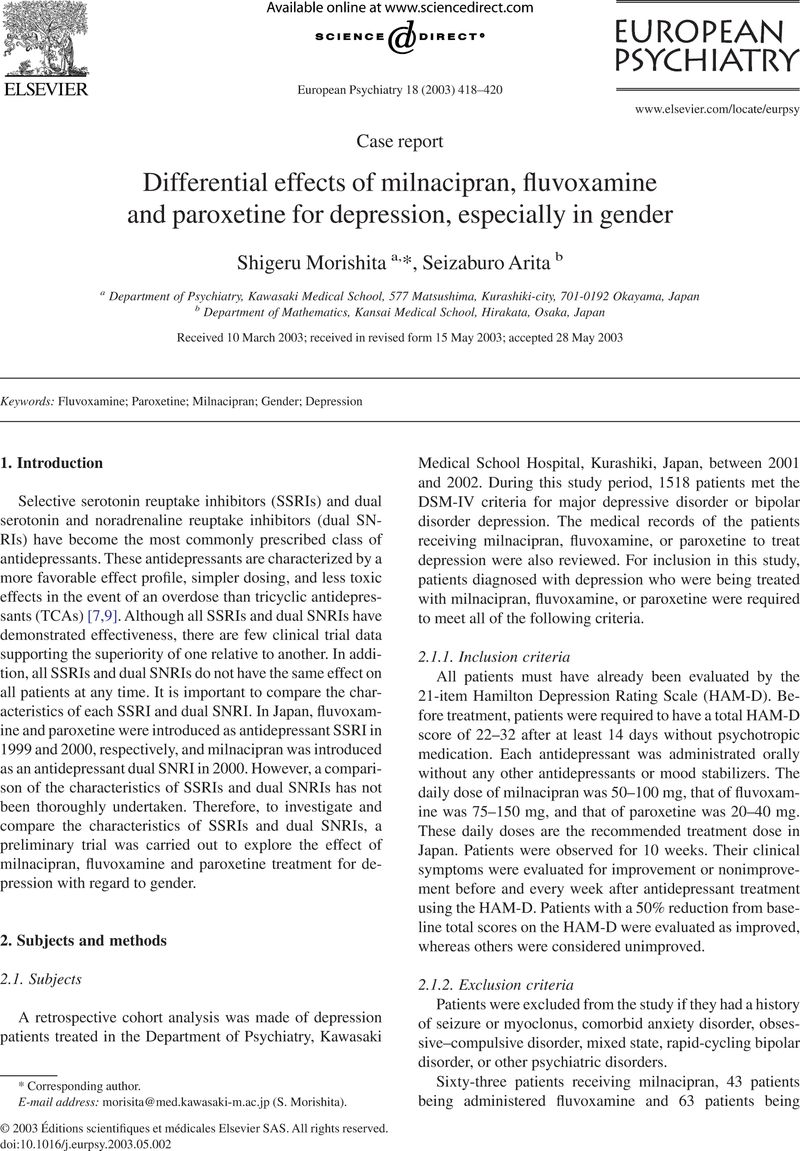Crossref Citations
This article has been cited by the following publications. This list is generated based on data provided by Crossref.
Morishita, Shigeru
and
Arita, Seizaburo
2004.
Efectos diferenciales del milnaciprán, la fluvoxamina y la paroxetina para la depresión, especialmente en el género.
European psychiatry (Ed. Española),
Vol. 11,
Issue. 2,
p.
124.
Morishita, Shigeru
and
Arita, Seizaburo
2004.
Differential effects of fluvoxamine, paroxetine and milnacipran for depression, especially with regard to age.
Human Psychopharmacology: Clinical and Experimental,
Vol. 19,
Issue. 6,
p.
405.
Duman, Erdem N.
Kesim, Murat
Kadioglu, Mine
Ulku, Cunay
Kalyoncu, Nuri I.
and
Yaris, Ersin
2006.
Effect of gender on antinociceptive effect of paroxetine in hot plate test in mice.
Progress in Neuro-Psychopharmacology and Biological Psychiatry,
Vol. 30,
Issue. 2,
p.
292.
Higuchi, Teruhiko
and
Briley, Mike
2007.
Japanese experience with milnacipran, the first serotonin and norepinephrine reuptake inhibitor in Japan.
Neuropsychiatric Disease and Treatment,
Vol. 3,
Issue. 1,
p.
41.
NAITO, SHINGO
SATO, KAZUHIRO
YOSHIDA, KEIZO
HIGUCHI, HISASHI
TAKAHASHI, HITOSHI
KAMATA, MITSUHIRO
ITO, KENICHI
OHKUBO, TADASHI
and
SHIMIZU, TETSUO
2007.
Gender differences in the clinical effects of fluvoxamine and milnacipran in Japanese major depressive patients.
Psychiatry and Clinical Neurosciences,
Vol. 61,
Issue. 4,
p.
421.
Gartlehner, Gerald
Gaynes, Bradley N.
Hansen, Richard A.
Thieda, Patricia
DeVeaugh-Geiss, Angela
Krebs, Erin E.
Moore, Charity G.
Morgan, Laura
and
Lohr, Kathleen N.
2008.
Comparative Benefits and Harms of Second-Generation Antidepressants: Background Paper for the American College of Physicians.
Annals of Internal Medicine,
Vol. 149,
Issue. 10,
p.
734.
Wille, Sarah M. R.
Cooreman, Sarah G.
Neels, Hugo M.
and
Lambert, Willy E. E.
2008.
Relevant Issues in the Monitoring and the Toxicology of Antidepressants.
Critical Reviews in Clinical Laboratory Sciences,
Vol. 45,
Issue. 1,
p.
25.
Serna, M.C.
Cruz, I.
Real, J.
Gascó, E.
and
Galván, L.
2010.
Duration and adherence of antidepressant treatment (2003 to 2007) based on prescription database.
European Psychiatry,
Vol. 25,
Issue. 4,
p.
206.
Xu, Yong
Ma, Lei
Jiang, Wei
Li, Yuhong
Wang, Gang
and
Li, Rena
2017.
Study of Sex Differences in Duloxetine Efficacy for Depression in Transgenic Mouse Models.
Frontiers in Cellular Neuroscience,
Vol. 11,
Issue. ,
Becker, Maria
Abaev, Karin
Pinhasov, Albert
and
Ornoy, Asher
2022.
S-Adenosyl-Methionine alleviates sociability aversion and reduces changes in gene expression in a mouse model of social hierarchy.
Behavioural Brain Research,
Vol. 427,
Issue. ,
p.
113866.
Ishaq, Sara
and
Ahmed, Touqeer
2023.
Sexually Dimorphic Effects of Neuromodulatory Drugs on Normal and Stress-Induced Social Interaction in Rats.
Brain Sciences,
Vol. 13,
Issue. 10,
p.
1378.
Karami, Hossein
Mehrizi, Reza
Effatpanah, Mohammad
Rivandi, Azamsadat
Daroudi, Rajabali
Armand, Nezam
and
Ghamkhar, Leila
2025.
Uncovering antidepressant prescription patterns: a three-year analysis of outpatient trends.
BMC Psychiatry,
Vol. 25,
Issue. 1,




Comments
No Comments have been published for this article.